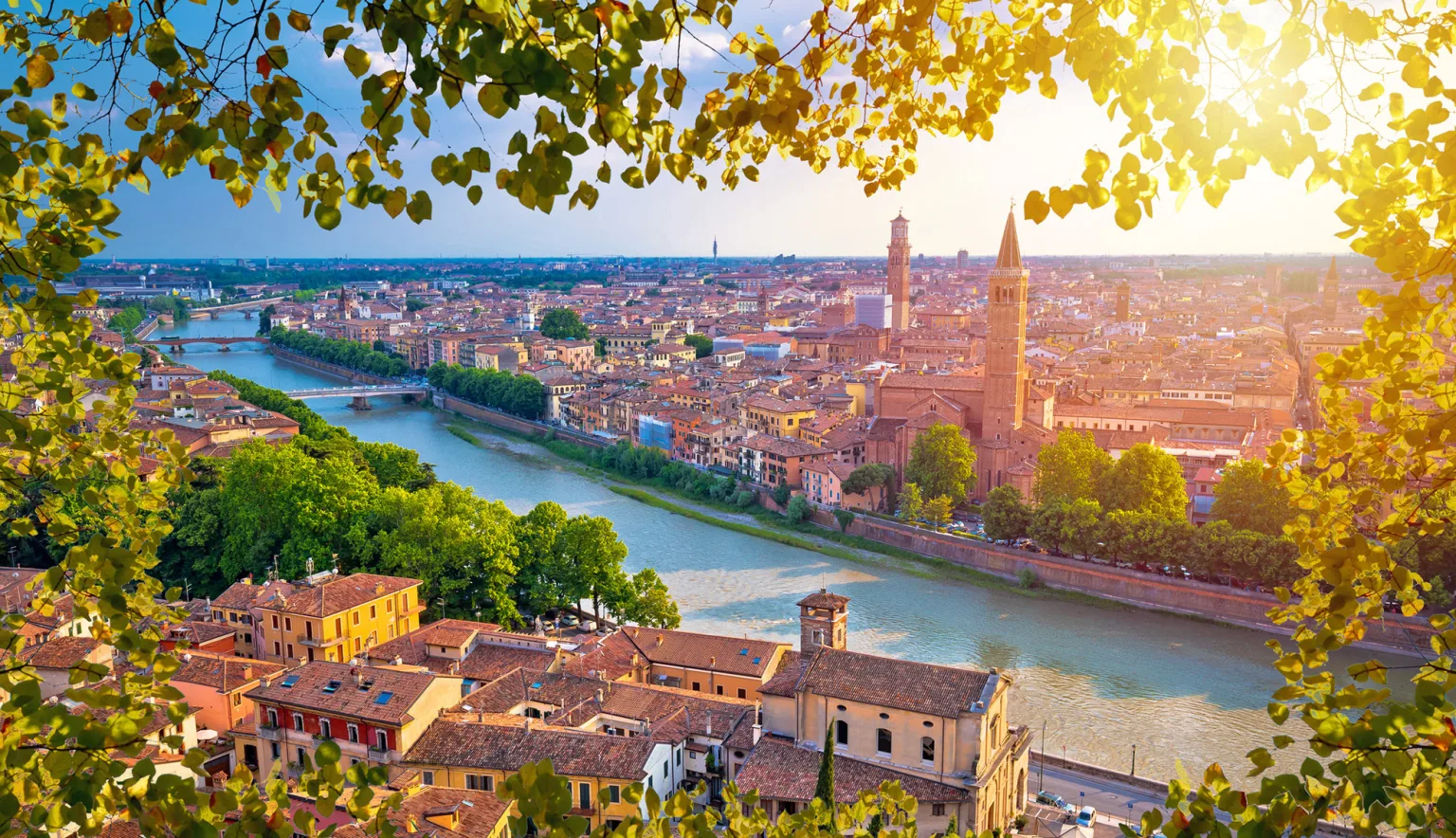To find out more about the Shakespearean legacy of Verona, Italy, we enjoy a walking tour with our guide, Christina.
Verona is known for being ‘the City of Love’, as it’s the setting for the world’s most famous romance, Shakespeare’s Romeo and Juliet. To find out more about the city’s Shakespearean legacy, we were taking a walking tour with Christina, a sparky, intelligent woman with curly dark hair and bright red nails.
We stood in the middle of the Piazza Brá on a misty morning in early February. In front of us was an impressive Roman amphitheatre, with archways built from pink sandstone. To its left was a bronze heart sculpture – people were queuing up for a selfie in front of it.
“Ninety percent of tourists come here because of Romeo and Juliet,” she told us.
Whether two lovers named Romeo and Juliet really existed is hotly debated. Some experts believe Shakespeare’s play is based on a story by a writer from Siena, who insisted his characters, star- crossed lovers Mariotto and Gianozzo, were real. What we do know is that two noble families called Montague and Capulet (or rather, Montecchi and Cappelletti) really did exist in medieval Verona.
“We have searched our records, because we really want them to exist,” Christina said frankly. “We found four Juliettas in the Cappelletti family. None of them died when they were young.”
But this hasn’t stopped tourists flocking to Verona by the millions in search of a romantic, Romeo- and-Juliet themed break.
Christina led us down the narrow streets of Verona’s historic centre, telling us about the Della Scala family, who ruled the city in the medieval period when Romeo and Juliet is set. She showed us the austere red brick houses that the family favoured, with their distinctive swallow-tail battlements. The shape of the battlements indicated support for a political faction called the Ghibellines (who were at war with their rivals, the Guelphs).
We stopped near one of these gothic, fortified houses.
“This is what we tell people is Romeo’s house,” Christina explained. “But actually, we aren’t sure. We know Cagnolo Nogaróla lived here. The Montecchi family definitely lived in this neighbourhood. It’s privately owned so we cannot go inside. They have a lot of trouble with people drawing heart graffiti on the door.”
Our next stop was Juliet’s house, which according to history really was owned by the Cappelleti family. We stepped into a small courtyard. Above us was a stone balcony dripping with flowers, which was supposedly where Juliet stood listening to Romeo’s first entreaties of love (reportedly added to the house’s façade by the city in 1936). Below it was a bronze statue of Juliet, which was surrounded by people waiting to take a photo with her. Many of them were squeezing her right breast.
“It’s supposed to be for good luck,” Christina said. “But nobody knows how it started. Maybe someone did it once and everyone copied, the poor girl.”
She told us about another unusual tradition in the city that stretches as far back as the 1930s – writing letters to Juliet. The first were placed at ‘Juliet’s tomb,’ which is in the crypt of the San Francesco al Corso Monastery (where Shakespeare set the tragic end of the play). Later, these letters were placed on the walls of Juliet’s house. But the city clamped down on this, as it was becoming an eyesore. These days, Juliet receives 8,000-10,000 letters a year, and a security guard stands in the courtyard, making sure they are placed in the post-box provided.
Any letters with return addresses are answered by the Juliet Club, a voluntary organisation established for this very purpose. It’s possible to visit its archive and see some of the letters. Christina had also gathered some anonymous letters herself over the years, which she showed us.
One was a heartwarming letter written by “Mom and Dad” to their children.
“We could tell you about Romeo and Juliet and how love will conquer all but we’d rather tell you about “real love”. You know, the kind of love that keeps you up at night because you’re taking care of your sick children,” it began.
Another letter, written on headed notepaper saying “Tim Burton’s The Nightmare Before Christmas”, mourned the ‘perfect lover’ who had broken up with her.
“We pretend like everything is normal between us when, deep down, we will never be able to forget that I have hairline fractures in three knuckles, two ribs and one heart because of him,” it concluded.
Reading the letter in its entirety gave me a lump in my throat. Perhaps Juliet was more than a gimmicky touristy offering – she was a figure enabling people across the world to pour their hearts out, when they felt nobody else was listening.
But of course, there’s far more to the city than its connection to Romeo and Juliet. Christina took us inside the echoing amphitheatre.
“In the past, these stone walls would have been painted in bright colours. Think Dolce and Gabbana, not Armani,” she told us.
She told us about the bloody battles that would have taken place in the arena, before moving on to discussing its current usage for opera performances – the pool once used for water battle reenactments had been drained for usage as the orchestra pit.
“Are there ever any accidents here?” my husband asked, as we climbed the stone steps to the top of the arena.
“Yes. Once a horse fell into the orchestra pit,” Christina said cheerfully.
This led on to a discussion of horsemeat, which is still used in traditional Veronese dishes. This was because there were many horse carcasses remaining after bloody battles, which were used as meat by the citizens.
“Sometimes, the carcasses would have lain for a few days in the summer. So they weren’t always fresh. People would stew them to hide any nasty taste,” Christina explained.
For lunch I tried this horsemeat stew, pastissada de caval, at one of Verona’s traditional inns, Osteria Sgarzie. It was rich with red wine, aromatic with the addition of rosemary, and served with a side of fresh polenta. Although I enjoyed it, I preferred my first course of soft sweet potato gnocchi, served with crispy bacon and smoked mozzarella cheese.
We spent the next couple of days exploring the city, stopping for breaks in cosy cafes to drink bitter expresso and snack on frittelle con cioccolato, chocolate-stuffed fried dough balls only cooked around the time of carnival. We wandered over the gothic Ponte di Castelvecchio to the Museo di Castelvecchio, where Veronese frescos, carvings and paintings were displayed in the chambers of a medieval castle.
One afternoon, the sun finally emerged from behind a cloud. It gilded the forested hills around the city, made the waters of the Adige shimmer. The orange and ochre facades of the beautiful Venetian buildings looked even brighter. Finally, as the soft afternoon light shone down, I understood why Verona deserved to be called ‘The City of Love.’





















